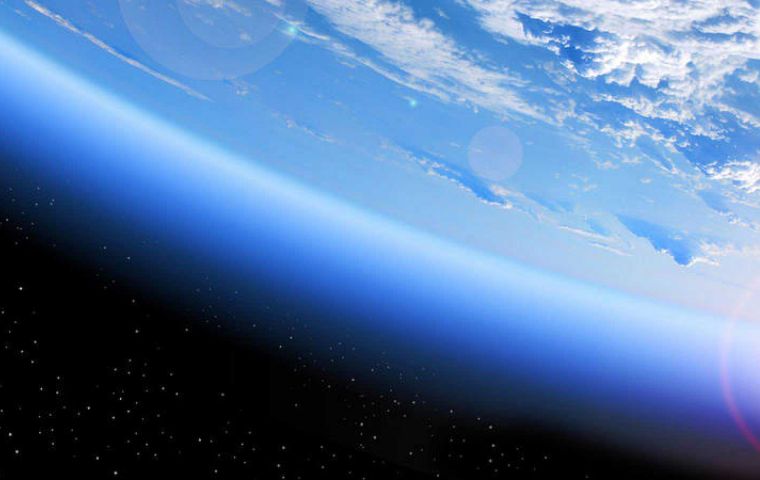MercoPress. South Atlantic News Agency
International Day for Protection of the Ozone Layer, 16 September
 In 1994, the UN General Assembly proclaimed 16 September the International Day for the Preservation of the Ozone Layer
In 1994, the UN General Assembly proclaimed 16 September the International Day for the Preservation of the Ozone Layer The ozone layer, a fragile shield of gas, protects the Earth from the harmful portion of the rays of the sun, thus helping preserve life on the planet. The phase-out of controlled uses of ozone-depleting substances and the related reductions have not only helped protect the ozone layer for this and future generations but have also contributed significantly to global efforts to address climate change; furthermore, it has protected human health and ecosystems by limiting the harmful ultraviolet radiation from reaching the Earth.
Montreal Protocol – keeping us, our food and vaccines cool
The Montreal Protocol started life as a global agreement to protect the ozone layer, a job it has done well, making it one of the most successful environmental agreements to date. A united global effort to phase out ozone-depleting substances means that today, the hole in the ozone layer is healing, in turn protecting human health, economies and ecosystems. But, as this year’s World Ozone Day seeks to highlight, the Montreal Protocol does so much more – such as slowing climate change and helping to boost energy efficiency in the cooling sector, which contributes to food security.
Background
Several commonly used chemicals are extremely damaging to the ozone layer. Halocarbons are chemicals in which one or more carbon atoms are linked to one or more halogen atoms (fluorine, chlorine, bromine or iodine). Halocarbons containing bromine usually have much higher ozone-depleting potential (ODP) than those containing chlorine. The man-made chemicals that have provided most of the chlorine and bromine for ozone depletion are methyl bromide, methyl chloroform, carbon tetrachloride and families of chemicals known as halons, chlorofluorocarbons (CFCs) and hydrochlorofluorocarbons (HCFCs).
Vienna Convention for the Protection of the Ozone Layer
The scientific confirmation of the depletion of the ozone layer prompted the international community to establish a mechanism for cooperation to take action to protect the ozone layer. This was formalized in the Vienna Convention for the Protection of the Ozone Layer, which was adopted and signed by 28 countries, on 22 March 1985. In September 1987, this led to the drafting of The Montreal Protocol on Substances that Deplete the Ozone Layer.
Montreal Protocol
The principal aim of the Montreal Protocol is to protect the ozone layer by taking measures to control total global production and consumption of substances that deplete it, with the ultimate objective of their elimination based on developments in scientific knowledge and technological information. It is structured around several groups of ozone-depleting substances. The groups of chemicals are classified according to the chemical family and are listed in annexes to the Montreal Protocol text. The Protocol requires the control of nearly 100 chemicals, in several categories. For each group or annexe of chemicals, the Treaty sets out a timetable for the phase-out of production and consumption of those substances, to eventually eliminate them.
The timetable set by the Protocol applies to the consumption of ozone-depleting substances. Consumption is defined as the quantities produced plus imported, less those quantities exported in any given year. There is also a deduction for verified destruction. Percentage reductions relate to the designated baseline year for the substance. The Protocol does not forbid the use of existing or recycled controlled substances beyond the phase-out dates.
There are a few exceptions for essential uses where no acceptable substitutes have been found, for example, in metered-dose inhalers (MDI) commonly used to treat asthma and other respiratory problems or halon fire-suppression systems used in submarines and aircraft.
In 1994, the United Nations General Assembly proclaimed 16 September the International Day for the Preservation of the Ozone Layer, commemorating the date of the signing, in 1987, of the Montreal Protocol on Substances that Deplete the Ozone Layer (resolution 49/114).
Implementation of the Montreal Protocol
Implementation of the Montreal Protocol progressed well in developed and developing countries. All phase-out schedules were adhered to in most cases, some even ahead of schedule. Attention focused initially on chemicals with higher ozone-depletion potentials including CFCs and halons. The phase-out schedule for HCFCs was more relaxed due to their lower ozone-depletion potentials and because they have also been used as transitional substitutes for CFCs.
The HCFC phase-out schedule was introduced in 1992 for developed and developing countries, the latter with a freeze in 2015, and the final phase-out by 2030 in developed countries and 2040 in developing countries. In 2007, Parties to the Montreal Protocol decided to accelerate the HCFC phase-out schedule for both developed and developing countries.
Universal ratification
On 16th September 2009, the Vienna Convention and the Montreal Protocol became the first treaties in the history of the United Nations to achieve universal ratification.
Kigali Amendment
The Parties to the Montreal Protocol on Substances that Deplete the Ozone Layer reached an agreement at their 28th Meeting of the Parties on 15 October 2016 in Kigali, Rwanda to phase down hydrofluorocarbons (HFCs).




Top Comments
Disclaimer & comment rulesCommenting for this story is now closed.
If you have a Facebook account, become a fan and comment on our Facebook Page!